
Circulation: Arrhythmia and Electrophysiology On the Beat
Paul J. Wang, MD
All episodes
Best episodes
Top 10 Circulation: Arrhythmia and Electrophysiology On the Beat Episodes
Goodpods has curated a list of the 10 best Circulation: Arrhythmia and Electrophysiology On the Beat episodes, ranked by the number of listens and likes each episode have garnered from our listeners. If you are listening to Circulation: Arrhythmia and Electrophysiology On the Beat for the first time, there's no better place to start than with one of these standout episodes. If you are a fan of the show, vote for your favorite Circulation: Arrhythmia and Electrophysiology On the Beat episode by adding your comments to the episode page.
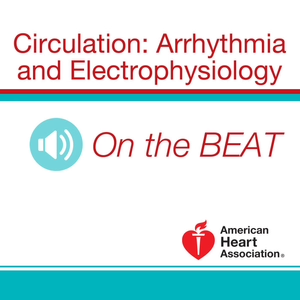
Circulation: Arrhythmia and Electrophysiology on the Beat July 2018
Circulation: Arrhythmia and Electrophysiology On the Beat
07/17/18 • 16 min
Dr Paul Wang: Welcome to the monthly podcast, On the Beat for Circulation: Arrhythmia and Electrophysiology. I'm Dr Paul Wang, Editor-in-Chief, with some of the key highlights from this month's issue.
In our first paper this month, Shaan Khurshid and associates determine the frequency of rhythm abnormalities in 502,627 adults in the UK Biobank, a national prospective cohort. They found that 2.35% had a baseline rhythm abnormality. The prevalence increased with age, with 4.84% of individuals aged 65 to 73 years having rhythm abnormalities. During over three million person- years of follow up, nearly 16,000 new rhythm abnormalities were detected. Atrial fibrillation was the most frequent with three per thousand person-years. Bradyarrhythmia with almost one per thousand person-years. Conduction system disease is about one per one thousand years. Supraventricular and ventricular arrhythmias, each about one half per one thousand person-years. Older age was associated with a hazard ratio of 2.35 for each 10 year increase. Male sex, hypertension, chronic kidney disease and heart failure were all associated with new rhythm abnormalities.
In our next paper, Fabien Squara and associates evaluated a method of determining the septal or free wall positioning of pacemaker or ICD leads during fluoroscopy. They compared in 50 patients a classical approach using posterior anterior, right anterior oblique 30 degrees, and left anterior oblique 40 degrees fluoroscopic imaging’s to 50 patients undergoing an individualized left anterior oblique or LAO approach. This individualized LAO approach view provided a true view of the interventricular septum. This angle was defined by the degree of LAO that allowed the perfect superimposition of the RV apex, using the tip of the right ventricular lead, temporarily placed at the apex, and one of the superior vena cava, inferior vena cava access using a guide wire. Transthoracic echo was used to confirm position of the right ventricular lead.
Septal, or free wall, right ventricular lead positioning was correctly identified in 96% of patients in the individualized group, versus 76% in the classical group. P equals 0.004. For septal lead positioning fluoroscopy had 100% sensitivity, and an 89.5 specificity in an individualized group, versus 91.4% sensitivity, and a 40% specificity in the classical group.
In our next paper, Elsayed Soliman and associates examined the lifetime risk of atrial fibrillation based on race and socioeconomic status. In the atherosclerosis risk in communities, ARIC, cohort, of 15,343 participants without atrial fibrillation, patients were recruited in 1987 to 1989, when they were 45 to 64 years of age, and followed through 2014. The authors identify 2,760 atrial fibrillation cases during a mean follow up of 21 years. The authors found that the lifetime risk of atrial fibrillation in the ARIC cohort was approximately one in three among whites, and one in five among African Americans. And, the socioeconomic status was inversely associated with cumulative incidents of atrial fibrillation before the last decades of life.
In our next paper, Jonathan Steinberg and associates sought to determine the impact of atrial fibrillation episode duration threshold on atrial fibrillation incidents and burden in pacemaker patients in a prospective registry. In 615 pacemaker patients was device detected atrial fibrillation over a mean follow up of 3.7 years, 599 had one or more atrial fibrillation episodes of 30 seconds duration, with a mean number of 22 episodes. At 12 months, freedom from atrial fibrillation ranged from 25.5% to 73.1%, based on a duration threshold from 30 seconds up to 24 hours. Of patients with a first episode of 30 seconds to two minutes, 35.8% were free from subsequent episodes greater than two minutes at 180 days. The mean atrial fibrillation burden of 0.2% for patients with first episodes between 30 seconds and 3.8 hours, was significantly less than the 9.5% burden for those with greater than 3.8 hours.
The authors concluded that small differences in atrial fibrillation episode duration definition can significantly affect the perceived incidents of atrial fibrillation impact reported outcomes, including atrial fibrillation success. An initial atrial fibrillation episode of 30 seconds does not predict clinically meaningful atrial fibrillation burden.
In the next paper, Hongwu Chen and Linsheng Shi and associates examined the distinct electrophysiologic features of bundle branch reentrant ventricular tachycardia in patients without structural heart disease. They described nine patients, mean age 29.6 years, with normal left ventricular function and bundle branch reentrant ventricular tachycardia, with a right bundle branch block pattern in one patient, and left bundle branch block patterns in nine patients. In all left bundle branch block pattern ventricular tachycardia, the mean ventricular tachycardia cyc...
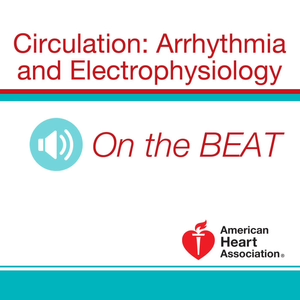
Circulation: Arrhythmia and Electrophysiology On the Beat August 2017
Circulation: Arrhythmia and Electrophysiology On the Beat
08/15/17 • 50 min
Dr. Wang: Welcome to the monthly podcast On The Beat for Circulation, Arrhythmia and Electrophysiology. I'm Dr. Paul Wang, editor-in-chief, with some of the key highlights from this month's issue. We'll also hear from Dr. Suraj Kapa, reporting on new research from the latest journal articles in the field.
This month's issue of Circulation: Arrhythmia and Electrophysiology has a number of fascinating and important articles. Let's start with the first article by Philip Halbfass and Associates, which describes the use of esophageal endoscopy in patients undergoing atrial fibrillation ablation. Of 1,802 patients undergoing afib ablation, 832 underwent post-procedural esophageal endoscopy. All patients were ablated using a single tip re-circular ablation catheter. Category one lesions described as erythema erosion were seen in 98 out of these 295 patients, while in 52 out of the 295 patients, ulceration was seen. In three of the 832 patients, esophageal perforation occurred, and in two of the 832 patients, atrial-esophageal fistula occurred.
Esophageal perforation only occurred in patients with category two lesions with an absolute risk of 9.6%. The authors concluded that post-ablation esophageal endoscopy is able to identify patients with high-risk lesions. One out of 10 patients with post-ablation esophageal ulcers progressed to perforation, while no patients without esophageal ulcers showed evidence of perforating complications.
In the next article by Christian Sohns and Associates describes the relationship between atrial fibrosis identified with magnetic resonance imaging and atrial rotor activity identified by noninvasive electrophysiological mapping. Ten patients underwent pulmonary vein isolation for persistent atrial fibrillation. Late gadolinium enhancement using magnetic resonance imaging, which projected onto the anatomy used for noninvasive electrophysiologic mapping.
The noninvasive electrophysiologic mapping identified 410 rotors evenly distributed between the left atrium and the right atrium. This study found that there was no statistically significant association between the presence of late gadolinium enhancement and the presence of rotors.
In the next article written by Jereon Venlet examines the endocardial unipolar voltage that best identifies abnormal epicardial electrograms. Thirty-three patients underwent endocardial epicardial right ventricular electro-anatomical mapping in ablation of right ventricular scar-related ventricular tachycardia. Eighty-six percent of abnormal epicardial electrograms had corresponding endocardial sites with bipolar electrogram less than 1.5 millivolts.
The remaining abnormal epicardial electrograms could be identified by endocardial unipolar voltages of less than 3.7 millivolts. The authors concluded that this use of endocardial unipolar voltage cut off at normal bipolar voltage sites improves the identification of all abnormal epicardial electrograms where there is less than 1 millimeter of fat.
The next article by Alan Bulava and Associates examines the outcomes of hybrid epicardial and endocardial radial frequency ablation, a persistent atrial fibrillation. Seventy patients underwent the epicardial thoracoscopic procedure followed by endocardial mapping ablation two to three months later. At the time of catheter ablation, 76% of patients were in sinus rhythm. All four pulmonary veins were found to be isolated in 69% of the patients and the left atrial posterior wall was isolated in 23% of the patients.
In the 12 months after the catheter ablation, 77% were arrhythmia-free, off antirrhythmic drugs. The majority of arrhythmia occurrences occur during the first 12 months following catheter ablation. Using previously ineffective antiarrythmics drugs and re-ablation procedures, arrhythmia-free survival increased to 97% during a mean followup of 936 days. Left atrial volume greater than 165 milliliters, the absence of sinus rhythm before catheter ablation and induce-ability of any sustained tachyarrhythmia at the end of catheter ablation predicted atrial fibrillation recurrence.
The authors concluded that the majority of patients after epicardial ablation required endocardial catheter ablation to complete the linear ablation or pulmonary vein isolation lesion sets. In the next article, Jason Roberts and Associates studied the clinical phenotype of Type 6 Long QT Syndrome, stemming from mutations in the KCNE2 encoded voltage gated channel beta subunit.
The authors examined individuals reported pathogenic KCNE2 mutations collected from inherited arrhythmia clinics in the Rochester LQTS registry as well as previously reported LQT6 cases identified through a med-line database search. Of 44 probands studied, 16 probands had resting QTC intervals and only developed QT prolongation and malignant arrhythmias following exposure to QT prolonging stressors. Ten had other Long QT pathogen...
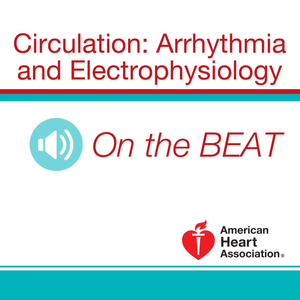
Circulation: Arrhythmia and Electrophysiology September 2018 Issue
Circulation: Arrhythmia and Electrophysiology On the Beat
09/18/18 • 11 min
Dr Paul Wang: Welcome to the monthly podcast On The Beat, where Circulation: Arrhythmia and Electrophysiology. I'm Doctor Paul Wang, editor in chief, with some of the key highlights from this month's issue.
In our first paper, Parikshit Sharma and associates reported on the use of permanent his bundle pacing to improve hemodynamics in 39 patients with right bundle branch block. His bundle pacing was successfully performed in 37, or 95 percent of the patients, and resulted in narrowing of the QRS complex from 158 milliseconds to 127 milliseconds. P = 0.0001. An increase in left ventricular ejection fraction from 31 percent to 39 percent. P = 0.004, an improvement in the New York Heart Association functional class from 2.8 to 2.0 P = 0.0001. This work suggests that his bundle pacing maybe helpful in right bundle branch block patients with left ventricular dysfunction.
In our next paper, Philippe Debruyne and associates added to our understanding of using catheter ablation to modulate the autonomic nervous system in patients with neurally mediated syncope, signs of no dysfunction and functional AV block. Prior reports of autonomic modulation using catheter ablation have required extensive ablation in both atria. In this article, the authors report a significant 95% reduction in syncope at six months as a result of targeted ablation in the right atrium alone, focusing on partial ablation of the interior right ganglionated plexus. Ablation is quite limited, taking a mean of seven minutes and creating a mean surface area of 11 millimeters squared. This technique has promise as a possible treatment for avoiding a need of pacemaker implantation in some patients.
In our next paper, Shankar Baskar and associates examined the characteristics and outcomes of pediatric patients receiving implantable cardioverter defibrillators and compared them to their adult counterparts. They examined ICD recipients in the NCDRICD registry from 2010 to 2016. There were 562,209 total ICD implants, including 3461 pediatric patients. Of the pediatric patients, 60 percent of implants were for primary prevention with non-ischemic cardiomyopathy being present in 60 percent of the patients, the most common underlying disease. Over time, there is an increasing trend of both primary and secondary prevention ICD implantations, P less than 0.05. Compared to adults, pediatric patients were likely to have structural heart disease, hypertrophic cardiomyopathy, ion channelopathy, and to receive a single chamber device. All P less than 0.001. There is no difference in in-hospital complications between the adult and the pediatric cohorts, 2.4 percent versus 2.6 percent. However, among pediatric patients, lower weight, Ebstein's anomaly, worse New York Heart Association class dual chamber and resynchronization defibrillator were associated with greater risk of complications. Although, re-intervention for generator replacement or upgrade was more common in adults, the time to re-intervention was shorter in the pediatric cohort.
In our next paper, Ahmed Hussein and associates examine the effect of using ablation index guiding ablation in 40 patients with persistent HO fibrillation on the rate of pulmonary vein reconnection. Pulmonary vein reconnection was seen as a mandatory repeat electro-physiologic study in 22 percent of patients, effecting seven percent of pulmonary veins. Ablation on the intravenous cryna was required in 44 percent of patients to achieve durable pulmonary vein isolation. Atrial tachyarrhythmia occurrence was documented in eight to 20 percent of patients, only one of whom had pulmonary vein reconnection at repeat study. At 12 months, 30 out of 40, or 95 percent of patients, were in sinus rhythm, with four or 10 percent of patients having starting antiarrhythmic drugs. Higher body mass index and excessive alcohol consumption were the only significant factors associated with atrial tachyarrhythmia occurrence.
In our next paper, Atsushi Hirayama and associates examined whether acute exasperation of chronic obstructive pulmonary disease increases the risk of repeated atrial fibrillation related health care utilization. They examine 944 patients who are hospitalized for acute exasperation of chronic obstructive pulmonary disease and had emergency department visit or hospitalization for atrial fibrillation during a 450 day period. Compared to the reference period, the rate of atrial fibrillation related emergency department visits or hospitalizations significantly increased in the first 90 days after acute exasperation of chronic obstructive pulmonary disease. 7.3 versus 14.1 per one hundred person months, resulting in a risk ratio of 1.93.
In our next paper, Namsik Yoon and associates examined the mechanisms underlying the electrocardiographic and arrhythmic manifestation of experimental models of early repolarization syndrome and the ameliorative effects of radio-frequency ablation....
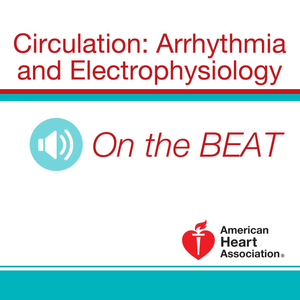
Circulation: Arrhythmia and Electrophysiology August 2018 Issue
Circulation: Arrhythmia and Electrophysiology On the Beat
08/21/18 • 10 min
Paul Wang: Welcome to the monthly podcast, On the Beat for Circulation: Arrhythmia and Electrophysiology. I'm Dr Paul Wang, editor-in-chief, with some of the key highlights from this month's issue. In our first paper from the Finland Group Registry, Nordenswan and her colleagues have further defined the risk of sudden cardiac death in ventricular arrhythmias in patients with cardiac sarcoidosis. While it has been observed that there's a high risk of lethal arrhythmias in cardiac sarcoidosis patients with high grade AV block, the incidents in these patients with lone AV block, in the absence of known VT or left ventricular dysfunction, has not been described. From the patients with myocardial inflammatory diseases in their registry, the authors identified 143 cardiac sarcoidosis patients with high grade AV block. Of these patients, 90 had lone AV block. For these patients, the five-year composite incidence of sudden cardiac death or VT was 24%, in comparison with 54% in AV block with ventricular tachycardia or severe left ventricular dysfunction, and 24% with AV block in non-severe left ventricular dysfunction.
These findings support implementation of an implantable cardioverter defibrillator for cardiac sarcoidosis patients with lone AV block. A recent study by Gold and Colleagues suggests atrial ventricular optimization improves reverse remodeling in patients with significant intraventricular electrical delay. In this sub-study of the Smart AV Trial, 275 subjects were randomized to either electrogram-based AV optimization, smart delay, or nominal AV delay, 120 milliseconds. In this mostly male cohort, with a mean age of 65 years, and a left ventricular ejection fraction of 28% at follow up, at six months the benefit of AV optimization increased as intraventricular electrical delay prolonged, defined as the time between the peaks of the right and left ventricular electrograms. The longest cohort trial of intraventricular conduction delay had 4.26 times greater odds of remodeling response with AV optimization compared with nominal AV delay. This suggests that the left ventricular lead position in AV optimization might have a synergistic effect in reverse remodeling in cardiac resynchronization patients.
Concerns have long been raised that anorexia nervosa causes QT interval prolongation predisposing these individuals to life-threatening ventricular arrhythmias and sudden cardiac death. Fredrickson and Associates made progress in challenging this conclusion, demonstrating that despite a slightly increased incidence in borderline mean QTC, greater than 440 milliseconds, in 430 female anorexia nervosa patients, compared to 123 healthy controls from the Danish Civil Register, there was no difference in the risk of prolonged corrected QT interval greater than 460 milliseconds between the two groups.
However, during a 10-year follow up, anorexia nervosa patients had a slightly increased risk of ventricular tachycardiac, aborted cardiac arrest, and cardiac arrest compared to healthy controls. Incidence of 0.5% in the anorexia nervosa patients versus 0.07% in healthy controls. In addition, anorexia nervosa patients had a significantly increased risk of all-cause mortality with a hazard ratio of 11.2 over 10 years compared to population-based cohort, suggesting that anorexia nervosa increases the risk of medical complications, including cardiac complications, but these are not directly related to anorexia nervosa's effects on corrected QT interval.
In our next paper, Ahmed Karim Talib and Associates reported on the outcomes of endocardial ablation of drug-resistant ventricular fibrillation in Brugada syndrome. Endocardial mapping ablation was performed in 21 patients with one or more episodes of ventricular fibrillation. Endocardial mapping revealed low voltage fractionated endocardial electrograms in 19% of patients. All patients underwent ablation of ventricular fibrillation triggers, followed by endocardial substrate modification. Noninducibility of ventricular fibrillation and normalization of Brugada ECG was documented in 14, in three patients, respectively. During a mean follow up of 54 months, seven patients, or 33%, experienced ventricular fibrillation recurrences, presence of cruris notching in D1 was associated with the presence of low-voltage fractionated endocardial electrograms in ablation failure.
In our next paper, Jae Yeong Cho and Associates tried to elucidate the mechanism of sudden cardiac death in patients with heart failure with preserved ejection fraction using an ambulatory recording in a rat model. They showed that rats who had a clinical phenotype of heart failure with preserved ejection fraction had prolonged QT and QTC intervals and reduced heart rate variability compared to the controls. Importantly, the rats with heart failure and preserved ejection fraction had significantly higher rates of spontaneous ventricular arrhythmias, and about a t...

Circulation: Arrhythmia and Electrophysiology On the Beat May 2018
Circulation: Arrhythmia and Electrophysiology On the Beat
05/15/18 • 15 min
Paul Wang: Welcome to the monthly podcast, On the Beat, for Circulation: Arrhythmia and Electrophysiology. I'm Dr. Paul Wang, editor-in-chief, with some of the key highlights from this month's issue.
In our first study, Filip Plesinger and associates examined whether a computerized analysis of the body surface 12-lead ECG can be used to measure the ventricular electrical activation delay as a predictor of heart failure or death following resynchronization therapy in a MADIT-CRT trial.
The authors found that left bundle branch block patients with baseline ventricular electrical activation delay less than 31.2 milliseconds had a 35% risk of MADIT-CRT endpoints, while patients with ventricular electrical activation delay greater than or equal to 31.2 milliseconds had a 14% risk, P value of less than 0.001.
The hazard ratio for predicting primary endpoints in patients with low ventricular electrical activation delay was 2.34 with a P value of less than 0.01. However, ventricular electrical activation delay was not predicted in patients with right bundle branch block or IVCD.
In our next study, Karl-Heinz Kuck and associates examined the predictors of long-term clinical outcomes after catheter ablation of atrial fibrillation in 750 patients in the FIRE AND ICE Trial. Using propensity score stratification methods to count for differences in baseline characteristics between sexes, the authors found that female sex with a hazard ratio of 1.37, P equals 0.01, and prior direct current cardioversion with a hazard ratio of 1.40, P equals 0.013 were independently associated with atrial fibrillation recurrence.
Female sex with hazard ratio of 1.36, P value of 0.035 and hypertension with a hazard ratio of 1.48, P value of 0.013 independently predicted cardiovascular rehospitalization. A longer history of atrial fibrillation with a hazard ratio of 1.03, P value of 0.039 increased the rate of repeat ablation.
After propensity score adjustment, women continued to have higher rates of primary efficacy failure with adjusted hazard ratio of 1.51, P less than 0.05 and cardiovascular rehospitalization with a hazard ratio of 1.40, P less than 0.05.
In the next study, Laura Bear and associates examined the reliability of inverse electrocardiographic mapping of cardiac electrical activity from recorded body surface potentials. In five anesthetized closed-chest pigs, torso and ventricular epicardial potentials were recorded simultaneously during sinus rhythm, epicardial, and endocardial ventricular pacing. Two approaches, coupled finite/boundary element methods and a meshless approach based on the method of fundamental solutions, were compared.
The authors found that inverse mapping underestimated epicardial potentials more than twofold, P less than 0.0001. Mean correlation coefficients for reconstructed epicardial potential distributions ranged from 0.60 to 0.64 across all methods. Epicardial electrograms were recovered with reasonable fidelity at approximately 50% of the sites, but variation was substantial.
General activation spread was reproduced with a mean correlation coefficient of 0.72 to 0.78 for activation time maps with spatio-temporal smoothing. Epicardial foci were identified with a mean location error approximately 16 millimeters. Inverse mapping with method of fundamental solutions was better than coupled finite/boundary element methods.
The authors concluded that spatio-temporal variability of recovered electrograms may limit the resolution, with implications for accuracy of arrhythmia localization.
In the next study, Pejman Raeisi-Giglou and colleagues examined the incidence of pulmonary vein stenosis in 10,368 patients undergoing atrial fibrillation ablation from 2000 to 2015. Computed tomography scans were performed three to six months after the procedures. Severe pulmonary vein stenosis was observed in 52 patients, or 0.5%. The left superior pulmonary vein represented 51% of all severely stenosed veins.
Percutaneous interventions were performed in 43 patients, and complications occurred in five, including three pulmonary vein ruptures, one stroke and one phrenic injury. Over a median follow-up of 25 months, 41, or 79%, of patients remained arrhythmia-free.
In our next paper, Koichi Nagashima and associates compared hot balloon ablation and cryoballoon ablation in a 165 consecutive patients who underwent initial atrial fibrillation catheter ablation. Of the 165 patients, 74 propensity score-matched patients equally divided between hot balloon ablation and cryoballoon ablation were studied.
Patients' characteristics included age, sex, body mass index, atrial fibrillation subtype, CHA2DS2-VASc score, and left atrial dimension were similar between the two groups. 52% of the hot balloon ablation patients required touch-up with radiofrequency ablation for residual/dormant pulmonary vein condu...
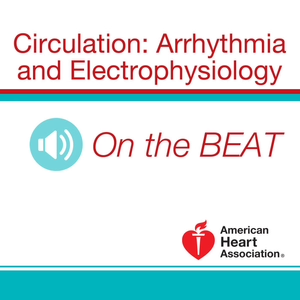
Circulation: Arrhythmia and Electrophysiology On the Beat March 2018
Circulation: Arrhythmia and Electrophysiology On the Beat
03/20/18 • 80 min
Paul Wang: Welcome to the monthly podcast “On The Beat”, for Circulation: Arrhythmia and Electrophysiology. I am Dr. Paul Wang, Editor-in-Chief, with some of the key highlights from this month's issue. We'll also hear from Dr. Suraj Kapa, reporting on new research from the latest journal articles in the field.
In our first article, Adetola Ladejobi and associates studied 1,433 patients, between 2000 and 2012, who were discharged alive after sudden cardiac arrest. A reversible and correctable cause was identified in 792 patients, or 55%. A reversible cause for sudden cardiac arrest was defined as significant electrolyte or metabolic abnormality, evidence of acute myocardial infarction or ischemia, recent initiation of antiarrhythmic drug, or illicit drug use, or other reversible circumstances.
Of the 792 sudden cardiac arrest survivors, due to reversible or correctable cause, 207 or 26% of the patients received an ICD after their indexed sudden cardiac arrest. During a mean follow-up of 3.8 years, 319 or 40% of patients died. ICD implantation was highly associated with a lower all-cause mortality, p < 0.001, even after correcting for unbalanced baseline characteristics.
In subgroup analyses, only patients with sudden cardiac arrest, were not associated with myocardial infarction, extracted benefit from the ICD, p < 0.001.
The authors concluded that in survivors of sudden cardiac arrest, due to a reversible and correctable cause, ICD therapies associated with lower all-cause mortality, except if the sudden cardiac arrest was due to myocardial infarction.
Further prospect of multi-center randomized control trials will be needed to confirm this observation.
In our next study, Carlo Pappone and associates, studied 81 patients with persistent atrial fibrillation, randomized to undergo high density electrophysiological mapping, to identify repetitive regular activities, before modified circumferential pulmonary vein ablation, or modified circumferential pulmonary vein ablation alone. The primary endpoint was freedom from arrhythmia recurrence at one year.
In the 81 patients with persistent atrial fibrillation, there were 479 regions exhibiting repetitive regular activities in these patients, or 5.9 repetitive regular activities per patient. There were 232 regions in the mapping group, which consisted of 41 patients, and 247 regions in the control group, consisting of 40 patients. Overall, 39% of the repetitive regular activities were identified within pulmonary veins, whereas 61% were identified in non-pulmonary vein regions.
Mapping-guided ablation resulted in higher arrhythmia termination rate, as compared to conventional strategy, 61% vs. 30%, p < 0.007. Total RF duration, mapping, and fluoroscopy times were not significantly different between the groups. No major procedure related adverse events occurred.
After one year, 73% of the mapping group of patients were free of recurrences, compared to 50% of the control group, p = 0.03.
The authors concluded that targeted ablation of regions showing repetitive regular activities provided adjunctive benefit in terms of arrhythmia freedom at one year in treatment of patients with persistent atrial fibrillation. These findings should be confirmed by additional larger randomized multi-centered studies.
In the next article, Maciej Kubala and associates examine repolarization abnormalities in 40 patients with arrhythmogenic right ventricular cardiomyopathy, comparing extent and location of abnormal T-waves of one millimeter or greater in depth, downsloping elevated ST segment in two or more adjacent leads to the area and location of endocardial bipolar and unipolar, and epicardial bipolar voltage abnormalities. They found an abnormal unipolar right ventricular endocardial area of 33.4% with presence in eight patients without negative T-waves. Patients with negative T-waves extending beyond V3, seen in 20 patients, had larger low bipolar and unipolar endocardial areas, and larger epicardial low bipolar areas, compared to those with negative T-waves limited to leads V1 to V3.
ECG localization of negative T-waves regionalized to the location of substrate. Patients with downsloping elevated ST segment, all localized to leads V1, V2 had more unipolar endocardial abnormalities involving outflow in mid-right ventricle, compared to patients without downsloping elevated ST segment.
The authors concluded that in arrhythmogenic right ventricular cardiomyopathy, abnormal electric current areas were proportional to the extent of T-wave inversion on the 12 lead electrocardiogram. Marked voltage abnormalities can exist without repolarization changes. Downsloping elevated ST segment patterns in V1 and V2 occurs with more unipolar endocardial voltage abnormalities, consistent with more advanced trans neural disease.
In the next manuscript, Teresa Oloriz ...
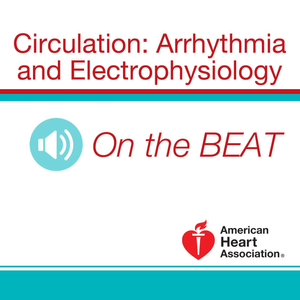
Circulation: Arrhythmia and Electrophysiology On the Beat February 2018
Circulation: Arrhythmia and Electrophysiology On the Beat
02/20/18 • 54 min
Dr Wong: Welcome to the monthly podcast, "On The Beat, for Circulation: Arrhythmia, and Electrophysiology." I'm doctor Paul Wong, editor in chief, with some of the key highlights from this month's issue. We'll also here from Dr. Suraj Kapa reporting on new research from the latest journal articles in the field.
In our first article, Mathew Daly and associates examine whether a high-resolution, 9 French, infrared thermography catheter can continuously image esophageal temperatures during atrial fibrillation catheter ablation. The infrared temperature catheter was inserted nasally or orally into the esophagus, adjacent to the left atrium. Endoscopy was performed within 24 hours to document esophageal injury. Thermal imaging showed that 10 out of 16 patients experienced one or more events where the peak esophageal temperature was greater than 40 degrees centigrade. Three patients experienced temperatures greater than 50 degrees centigrade and one experienced greater than 60 degrees centigrade. Analysis of temperature data from each subject's maximal thermal event revealed high radius, 2.3 degrees centigrade per millimeter and rates of change 1.5 degrees centigrade per second, with an average length of esophageal involvement of 11.0 millimeters.
Endoscopy identified three distinct thermal lesions, all in patients with temperatures greater than 50 degrees centigrade, all resolving within two weeks. The authors concluded that infrared thermography, high-resolution mapping of esophageal temperatures during catheter ablation may be performed. Esophageal thermal injury occurs with temperatures greater than 50 degrees centigrade, and was associated with large spacial-temporal gradients.
In our next article, Nitesh Sood and associates reported on the real-world incidence and predictors of perioperative complications in transvenous lead extractions involving ICD leads in the NCDR ICD registry. Lead extraction was defined as removal of leads implanted for greater than one year. Predictors of major perioperative complication for all extraction procedures, 11,304, and for high voltage leads, 8,362, or 74% across 762 centers were analyzed, using univariate and multivariate logistic regression. Major complications occurred in 258, or 2.3% of the extraction procedures. Of these, 258 procedures with a complication, 41 or 16% required urgent cardiac surgery. Of these, 14 or 34% died during surgery. Among the total 98, or 0.9% deaths reported, 18 or 0.16% of the total occurred during extraction.
In multivariate, logistic regression analysis of all extractions, female sex, admission other than electively for the procedure, three or more leads extracted, longer implant duration, dislodgement of other leads, patients' clinical status, requiring lead extraction, such as infection or perforation, were associated with increased risk of complications. For high voltage leads, smaller lead diameter, a flat versus round coil shape, in greater proximal surface coil area, were multivariate predictors of major perioperative complications.
The rate of major complications and mortality with transvenous lead extraction is similar in the real world compared to single center studies from high volume centers. There remains a significant risk of urgent cardiac surgery with a very high mortality, and planning for appropriate cardiothoracic surgical backup is imperative.
In our next paper, Bence Hegyi and associates, have reported on the repolarization reserve in failing rabbit ventricular myocytes, and the role of calcium and beta-adrenergic effects on delayed and inward rectifier potassium currents. The authors measured the major potassium currents, IKr, IKs, IK1, and their calcium and beta-adrenergic dependence in rabbit ventricular myocytes, in chronic pressure, in volume overload, induced heart failure, and compared them to age-matched controls.
The authors made a number of observations. One, action potential duration was significantly prolonged only at lower pacing rates, 0.2 to 1 Hertz, in heart failure under physiological ionic conditions and temperature. Two, beat to beat variability of action potential duration was also significantly increased in heart failure. Three, both IKr and IKs were significantly regulated in heart failure under action potential clamp but only when cytosolic calcium was not buffered. Four, CaMKII inhibition abolished IKs upregulation in heart failure, but did not affect IKr. Five, IKs response to beta-adrenergic stimulation was also significantly diminished in heart failure, and, six, IK1 was also decreased in heart failure regardless of calcium buffering, CaMKII inhibition or beta-adrenergic stimulation.
These observations changed when cytosolic calcium was buffered. The action potential prolongation in heart failure was also significant in higher pacing rates. The authors concluded that in heart failure, calcium dependent up regulation of IKr ...

Circulation: Arrhythmia and Electrophysiology May 2020 Issue
Circulation: Arrhythmia and Electrophysiology On the Beat
12/16/20 • 17 min
Paul J. Wang:
Welcome to the monthly podcast, On the Beat for Circulation: Arrhythmia and Electrophysiology. I'm Dr. Paul Wang, Editor-in-Chief, with some of the key highlights from this month's issue. In our first paper, Bruce Wilkoff and associates examine the impact of cardiac implantable electronic device [CIED] infections on mortality, quality of life, healthcare utilization, and cost in the U.S. Healthcare system. They found that the majority CIED infection was associated with increased all-cause mortality, 12-month risk-adjusted hazard ratio 3.41, P < 0.001. An effect that sustained beyond 12 months.
The quality of life was reduced, P = 0.004, and did not normalize for six months. Disruptions in CIED therapy were observed in 36% of infections for a median duration of 184 days. The authors reported that the mean hospital costs were $55,547.
In our next paper, Songwen Chen, Xiaofeng Lu and associates examine the ability to eliminate premature ventricular complexes [PVCs] originating from the proximal left anterior fascicle, safely from the right coronary sinus. The authors mapped the the right coronary sinus and left ventricle in 20 patients with left anterior fascicle PVCs. They found that the earliest activation site with Purkinje potential during both PVC and sinus rhythm was localized at proximal left anterior fascicle in eight patients, the proximal group, or non-proximal left anterior fascicle in 12 groups, the non-proximal group. The Purkinje potentials proceeded PVC-QRS at the earliest activation site in proximal group 32.6 milliseconds was significantly earlier than that in non-proximal group, 28.3 milliseconds P = 0.025. Similar difference in the Purkinje potentials proceeding sinus QRS at the earliest activation site was also observed between proximal and non-proximal group, 35.1 milliseconds versus 25.2 milliseconds, P < 0.001.
In proximal group, the distance between the earliest activation site to the left His-bundle into the right coronary sinus were shorter than that of the non-proximal group 12.3 millimeters versus 19.7, P = 0.002, and 3.9 millimeters versus 15.7 millimeters, P < 0.001, respectively. The authors found no difference in the distance between the right coronary sinus to proximal left anterior fascicle between the two groups. PVCs were successfully eliminated from the right coronary sinus in all proximal group, but at left ventricular earliest activation site for the non-proximal group, the radiofrequency application time, ablation time and procedure time of non-proximal group were longer than that proximal group.
Electrocardiographic analysis showed that when compared to non-proximal group, the PVCs proximal group had a narrower QRS duration, smaller S wave in leads one, V five,and V six; lower R waves in leads one, aVL, aVR, V one, V two, and V four and smaller q wave in leads three and aVF. The QRS duration difference [PVC-QRS and sinus rhythm QRS] < 15 milliseconds predicted the proximal left anterior fascicle origin with high sensitivity and specificity.
In our next paper, Benjamin Steinberg and associates examined the factors that are associated with large improvements in health-related quality of life in patients with atrial fibrillation. The authors assessed factors associated with a one-year increase in quality of life, measured by AFEQT of one standard deviation that is greater and equal to 18 points, three times clinically important difference among patients in the ORBIT-AF one registry. They found that 28% of patients had such a health-related quality improvement compared with patients not showing large health-related quality of life improvement. They were similar age, (median 73 versus 74 years of age), equally likely to be female, (44% versus 48%), but more likely to have newly diagnosed atrial fibrillation [AF] at baseline (18% versus 8%, P = 0.0004) prior antiarrhythmic drug use (52% versus 40%, P = 0.005), baseline antiarrhythmic drug use (34.8% versus 26.8%, P = 0.045), and more likely to undergo AF related procedures during follow-up (AF ablation 6.6% versus 2.0%, cardioversion 12.2% versus 5.9%). In multivariate analysis, a history of alcohol abuse has a ratio 2.4 and increased baseline diastolic blood pressure has a ratio 1.23 per 10 point increase and greater than 65 millimeters of mercury were associated with large improvements in health-related quality of life at one year. Whereas patients with prior stroke, chronic obstructive pulmonary disease and peripheral artery disease were less likely to improve.
In our next paper, Eiichi Watanabe and associates studied safety and resource consumption of exclusive remote follow-up in pacemaker patients for two years. Consecutive pacemaker patients committed to remote pacemaker management were randomized to either remote follow-up or conventional in-office follow-up at twice yearly intervals.
Remote follow-up patients were only seen if i...
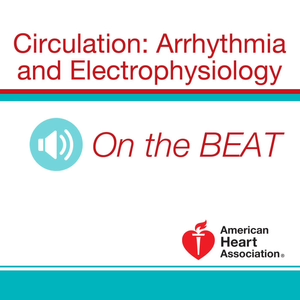
Circulation: Arrhythmia and Electrophysiology March 2019 Issue
Circulation: Arrhythmia and Electrophysiology On the Beat
03/25/19 • 15 min
Dr Paul Wang: Welcome to the monthly podcast "On the Beat" for Circulation: Arrhythmia, and Electrophysiology. I'm Dr Paul Wang, Editor-in Chief, with some of the key highlights from this month's issue.
In our first manuscript, Marie Bayer Elming and associates, examined whether the right ventricular ejection fraction can identify patients with non-ischemic systolic heart failure, more likely to benefit from ICD implantation. The Danish study, to assess the efficacy of ICDs in patients with non-ischemic systolic heart failure, on mortality, the Danish study, randomized patients with non-ischemic systolic heart failure to ICD our control. In 239 patients with interpretable cardiovascular magnetic resonance images, the right ventricular volume and ejection fraction was measured. Right ventricular ejection fraction was an independent predictor of all-cause mortality, with a hazard ration 1.34 per 10% absolute decrease in our right ventricular ejection fraction. P=0.02. There is statistically significant interaction between right ventricular ejection fraction and the effect of ICD implantation. P=0.001. ICD implantation significantly reduced all-cause mortality in patients with right ventricular systolic dysfunction. Hazard ratio 0.41, but not in patients without right ventricular systolic dysfunction.
Thus, in this post-hoc analysis of the Danish trial, ICD therapy was associated with survival benefit in patients with bi-ventricular heart failure.
In our next paper, Dawn Pedrotty and Volodymyr Kuzmenko and associates, have proposed a concept of using a stretchable, flexible, bio patch, with conductive properties, to attempt to restore conduction across regions in which activation is disrupted. They use carbon nanotube patches, composed of nanofibrillated cellulose, in single wall carbon nanotube ink, 3-D printed in conductive patterns onto bacterial nanocellulose.
Electro anatomic mapping was performed on normal epicardium and repeated over surgically disruptive epicardium, and finally with the patch applied passively. The patch resulted in restored conduction based on mapping.
In our next paper, Ayman Hussein and colleagues developed a fully automated platform to collect patient reported outcomes in a prospective cohort of atrial fibrillation ablation. Two thousand one hundred and seventy-five patients were eligible to receive 10,903 patient reported outcome assessment invitations. More follow up assessments were obtained with automated patient reported outcomes in routine follow-up, compared with routine follow up alone, P > 0.001, which allowed for longer duration of follow up, 378 vs 217 days. By automated patient reported outcomes, a large number of disease specific variables were collected and showed improvement in quality of life. Baseline median AF symptom severity score of 12 and ranged between 2 and 3 on subsequent assessments, P > 0.0001. This improvement was also true for each of the atrial fibrillation symptom severity score components. In patient reported outcomes, there was a significant reduction in atrial fibrillation burden, such as frequency and duration episodes and associated healthcare utilization including emergency visits and hospitalizations after the ablation procedures.
In our next paper, Nicolas Johner, Dipen Shah, and associates, examined the role of post pacing intervals shorter than tachycardia cycling during entrainment mapping. The author studied 24 non-cavotricuspid isthmus dependent macro oriented atrial flutters in 19 consecutive patients. High density electro anatomic activation maps were acquired with a 64-electrode basket catheter of 102 entrainment mapping sites. Post pacing interval difference less than 30 was observed at 72 sites on complete maps of 24 atypical atrial flutters compared to sites with the difference in post pacing intervals 0 to 30, with 45 sites difference in the post pacing interval less than 0 at 27 were more commonly located within isthmuses less than 15mm wide and more frequently located in within 5mm of the leading wave front. It also exhibited slower local conduction, lower voltages in more frequently fractioned electrograms. The authors concluded that in atrial flutter, sites with differences with the post pacing interval are markers of limited width critical isthmuses with slower conduction velocity, while sites with difference in post pacing interval 0 to 30ms are often not in close proximity to the reentrance circuit. Virtual electrode simultaneous down and up stream, antidromic capture of a confined isthmus of slow conduction can explain a difference in the post pacing interval less than 0.
In the next paper, José Manuel Alfonso-Almazán, and associates studied the safety and efficacy parameters associated with catheter-based radiofrequency delivery at the root of the aorta and pulmonary artery. The author studied 34 pigs undergoing in vivo catheter based ablation using cont...
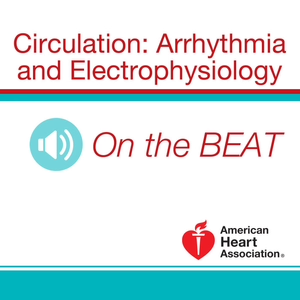
Circulation: Arrhythmia and Electrophysiology October 2019 Issue
Circulation: Arrhythmia and Electrophysiology On the Beat
10/21/19 • 16 min
Dr Paul Wang: Welcome to the monthly podcast, On the Beat for Circulation: Arrhythmia and Electrophysiology. I'm Dr Paul Wang, editor in chief, with some of the key highlights from this month's issue.
In our first paper, in a single‐center observational cohort study, Owen Donnellan and Associates compared arrhythmia recurrence rates in morbidly obese patients who underwent prior bariatric surgery, with those of non-obese patients following atrial fibrillation ablation. In addition to morbidly obese patients who did not undergo bariatric surgery, they matched 51 morbidly obese patients' body mass index, 40 kilograms per meter squared, who had undergone prior bariatric surgery in a two to one manner with 102 non-obese patients, and 102 morbidly obese patients without bariatric surgery on the basis of age, gender, and timing of atrial fibrillation ablation. From the time of bariatric surgery to ablation, bariatric surgery was associated with a significant reduction in BMI. 47.6 to 36.7 and reduction in systolic blood pressure, 145 to 118, P < 0.001.
During a mean follow up of 29 months following ablation, recurrent arrhythmia occurred in 10 out of 51 or 20 patients in a bariatric surgery group, compared to 25 out of 102 patients, 24.5% in a non-obese group, and 56 out of 102 or 55% in the non-bariatric surgery morbidly obese group. No procedural complications were observed in the bariatric surgery group. In our next paper, Martin Andreas and Associates examined whether noninvasive, low-level, transcutaneous electrical stimulation of the greater auricular nerve reduced the risk of postoperative atrial fibrillation, in a pilot of patients undergoing cardiac surgery. After cardiac surgery, electrodes were applied in the triangular fossa of the ear. Stimulation, amplitude 1-million-amp frequency, one Hertz for 40 minutes, followed by a 20-minute break, was performed for up to two weeks after cardiac surgery. Patients were randomized into sham, N equals 20 or treatment group, N equals 20, for low- level, transcutaneous electrical stimulation. Patients receiving low-level, transcutaneous stimulation had a significant reduced incidence of postoperative atrial fibrillation. Four out of 20, compared to controls 11 out of 20. P equals 0.02.
The median duration of postoperative atrial fibrillation was comparable between the treatment group and control group. No effect on low-level stimulation on CRP or IL-6 levels was detectable. In our next paper, Kazuki Iso and Associates examine whether the vagal response phenomenon is common to patients without atrial fibrillation. Continuous, high- frequent stimulation of the left atrial ganglion and plexus was performed in 42 patients, undergoing ablation for atrial fibrillation. In 21 patients undergoing ablation for left-sided accessory pathway, the high frequency stimulation, 20 Hertz at 25 milliamps of 10 millisecond pulse duration, was applied for five seconds at three sites within the presumed anatomical area of each of the five major left atrial ganglion plexus, for a total of 15 sites per patient. The authors define vagal response to high frequency stimulation, as prolongation of the R interval by > 50% in comparison to the mean pre-high-frequency stimulation RR interval, average over 10 beats.
In active ganglion plexus areas, is areas in which vagal response was elicited. Overall, more active ganglion plexi or GP areas were found in the atrial fibrillation group patients, than in the non-atrial fibrillation group patients. And in all five major GPS, the maximum R interval during high-frequency stimulation was significantly prolonged in atrial fibrillation patients. After multivariate adjustment, association was established between the total number of vagal response sites and the presence of atrial fibrillation. The authors concluded that the significant increase in vagal responses elicited in patients with atrial fibrillation, compared to responses in non-atrial fibrillation patients, suggests that the vagal responses is to hypercan stimulations, reflect an abnormally increased ganglion plexi activity, specific to atrial fibrillation substrates.
In our next paper, Vidal Essebag and Associates combine the data from the Bruise Control One and Two studies to evaluate the effect of concomitant antiplatelet therapy on clinically significant hematomas, and to understand the relative risk of clinically significant hematomas in patients treated with DOAC versus continued Warfarin. The Bruise Control study demonstrated that perioperative Warfarin continuation, reduced clinically- significant hematomas by 80%, compared to Heparin bridging. 3.5% versus 16%. Bruise Control Two observed a similarly low risk of clinically-significant hematomas when comparing continued versus interrupted direct oral anticoagulant. 2.1% in both groups. A total of 1,343 patients were included in Bruise Control One and Bruise Control Two, the primary out...
Show more best episodes

Show more best episodes
FAQ
How many episodes does Circulation: Arrhythmia and Electrophysiology On the Beat have?
Circulation: Arrhythmia and Electrophysiology On the Beat currently has 42 episodes available.
What topics does Circulation: Arrhythmia and Electrophysiology On the Beat cover?
The podcast is about Health & Fitness, Cardiology, Natural Sciences, Medicine, Podcasts and Science.
What is the most popular episode on Circulation: Arrhythmia and Electrophysiology On the Beat?
The episode title 'Circulation: Arrhythmia and Electrophysiology January 2020 Issue' is the most popular.
What is the average episode length on Circulation: Arrhythmia and Electrophysiology On the Beat?
The average episode length on Circulation: Arrhythmia and Electrophysiology On the Beat is 27 minutes.
How often are episodes of Circulation: Arrhythmia and Electrophysiology On the Beat released?
Episodes of Circulation: Arrhythmia and Electrophysiology On the Beat are typically released every 28 days.
When was the first episode of Circulation: Arrhythmia and Electrophysiology On the Beat?
The first episode of Circulation: Arrhythmia and Electrophysiology On the Beat was released on Jun 1, 2017.
Show more FAQ

Show more FAQ